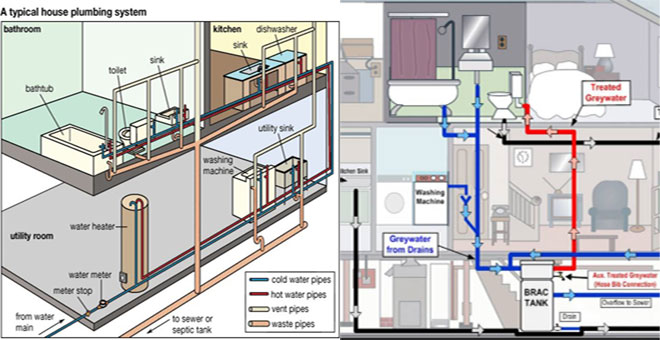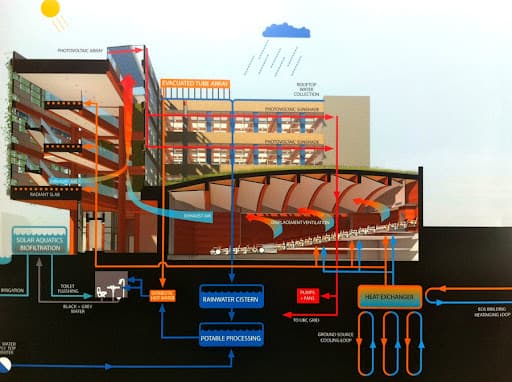A Comprehensive Guide to Your House's Plumbing System Anatomy
A Comprehensive Guide to Your House's Plumbing System Anatomy
Blog Article
What're your thoughts about The Inner Workings of Your Home's Plumbing?

Comprehending how your home's pipes system works is necessary for every home owner. From providing tidy water for drinking, food preparation, and bathing to securely removing wastewater, a properly maintained plumbing system is crucial for your family's health and comfort. In this comprehensive guide, we'll check out the complex network that composes your home's plumbing and deal ideas on maintenance, upgrades, and taking care of typical problems.
Introduction
Your home's pipes system is greater than simply a network of pipelines; it's a complicated system that guarantees you have access to clean water and effective wastewater removal. Understanding its components and how they collaborate can assist you protect against costly fixings and ensure every little thing runs smoothly.
Standard Elements of a Plumbing System
Pipelines and Tubing
At the heart of your plumbing system are the pipelines and tubing that lug water throughout your home. These can be made of numerous materials such as copper, PVC, or PEX, each with its benefits in regards to toughness and cost-effectiveness.
Fixtures: Sinks, Toilets, Showers, and so on.
Fixtures like sinks, toilets, showers, and tubs are where water is made use of in your house. Understanding how these fixtures connect to the plumbing system aids in diagnosing troubles and intending upgrades.
Shutoffs and Shut-off Points
Valves control the flow of water in your plumbing system. Shut-off shutoffs are crucial during emergency situations or when you require to make fixings, permitting you to separate parts of the system without interrupting water flow to the entire house.
Supply Of Water System
Main Water Line
The major water line attaches your home to the local supply of water or a personal well. It's where water enters your home and is distributed to various components.
Water Meter and Stress Regulator
The water meter measures your water use, while a stress regulator guarantees that water flows at a secure stress throughout your home's plumbing system, preventing damages to pipes and fixtures.
Cold Water vs. Warm water Lines
Comprehending the distinction in between cold water lines, which supply water directly from the major, and hot water lines, which carry warmed water from the water heater, helps in repairing and planning for upgrades.
Water drainage System
Drain Pipes Pipeline and Traps
Drain pipelines carry wastewater far from sinks, showers, and commodes to the drain or septic tank. Traps stop sewer gases from entering your home and additionally catch debris that might cause obstructions.
Ventilation Pipes
Air flow pipes enable air into the drain system, preventing suction that can slow water drainage and trigger catches to empty. Correct ventilation is crucial for preserving the honesty of your plumbing system.
Relevance of Appropriate Water Drainage
Making sure proper drain prevents back-ups and water damages. Frequently cleaning drains and keeping traps can stop costly fixings and extend the life of your pipes system.
Water Heater
Types of Water Heaters
Water heaters can be tankless or conventional tank-style. Tankless heating systems heat water as needed, while containers save warmed water for instant use.
Updating Your Plumbing System
Factors for Updating
Updating to water-efficient fixtures or changing old pipes can boost water top quality, lower water bills, and boost the worth of your home.
Modern Plumbing Technologies and Their Benefits
Check out modern technologies like smart leak detectors, water-saving bathrooms, and energy-efficient hot water heater that can conserve cash and reduce environmental effect.
Price Factors To Consider and ROI
Calculate the upfront expenses versus long-lasting financial savings when considering plumbing upgrades. Many upgrades pay for themselves with minimized energy costs and less repairs.
How Water Heaters Connect to the Plumbing System
Understanding how water heaters connect to both the cold water supply and hot water distribution lines helps in detecting issues like insufficient warm water or leakages.
Upkeep Tips for Water Heaters
Consistently purging your hot water heater to get rid of debris, examining the temperature level settings, and examining for leaks can extend its life-span and boost energy efficiency.
Usual Pipes Concerns
Leakages and Their Reasons
Leaks can occur due to aging pipelines, loosened installations, or high water pressure. Dealing with leaks immediately avoids water damage and mold development.
Blockages and Obstructions
Clogs in drains and commodes are usually brought on by purging non-flushable products or an accumulation of grease and hair. Utilizing drain screens and bearing in mind what goes down your drains pipes can stop blockages.
Signs of Pipes Issues to Expect
Low tide pressure, slow-moving drains pipes, foul odors, or unusually high water bills are signs of possible pipes problems that need to be attended to quickly.
Pipes Upkeep Tips
Regular Examinations and Checks
Arrange annual pipes evaluations to capture problems early. Look for indicators of leaks, rust, or mineral build-up in faucets and showerheads.
Do It Yourself Maintenance Tasks
Straightforward tasks like cleaning tap aerators, checking for toilet leaks making use of dye tablet computers, or protecting exposed pipelines in cold environments can protect against major pipes problems.
When to Call a Specialist Plumbing Technician
Know when a plumbing problem requires professional expertise. Trying complex repair services without correct understanding can bring about more damage and greater repair work prices.
Tips for Reducing Water Use
Straightforward practices like dealing with leaks immediately, taking much shorter showers, and running full tons of washing and dishes can save water and lower your energy bills.
Eco-Friendly Plumbing Options
Take into consideration sustainable plumbing materials like bamboo for floor covering, which is durable and green, or recycled glass for counter tops.
Emergency Preparedness
Actions to Take Throughout a Plumbing Emergency
Know where your shut-off shutoffs lie and just how to shut off the water in case of a burst pipe or significant leakage.
Importance of Having Emergency Contacts Helpful
Keep get in touch with info for neighborhood plumbings or emergency situation services readily available for quick action throughout a pipes situation.
Environmental Impact and Conservation
Water-Saving Fixtures and Home Appliances
Setting up low-flow taps, showerheads, and bathrooms can substantially lower water use without sacrificing performance.
DIY Emergency Situation Fixes (When Applicable).
Short-term fixes like using duct tape to patch a leaking pipe or placing a bucket under a trickling tap can decrease damages till a specialist plumbing professional gets here.
Verdict.
Recognizing the anatomy of your home's plumbing system empowers you to keep it properly, conserving time and money on repair work. By following regular upkeep regimens and staying informed concerning modern-day pipes technologies, you can ensure your pipes system operates efficiently for years ahead.
Exploring Your Homes Plumbing Anatomy
Water Supply System
Main Water Line: This is where water enters your home from the municipal supply or a private well. Water Meter: Typically located near where the main water line enters the property, it measures the amount of water used. Shutoff Valve: It s crucial to know where this is in case of emergencies. It allows you to turn off the water supply to the entire house. Pipes and Fittings: These distribute water throughout your home. Materials can include copper, PVC, or PEX. Drain-Waste-Vent (DWV) System
Drains: Located in sinks, showers, and tubs, these carry wastewater away. Traps: U-shaped pipes under sinks that hold standing water, blocking sewer gases from entering the home. Vents: Pipes that lead from the DWV system to the outside, preventing vacuum formation and allowing gases to escape. Sewer Line: Carries all wastewater from the home to the municipal sewer system or a septic tank. Fixtures and Appliances
Sinks, Toilets, and Showers Dishwashers and Washing Machines Water Heaters Maintenance Tips
Regularly check for leaks in exposed pipes and around fixtures. Inspect the water heater annually for signs of wear. Clean drains and traps to prevent clogs and odors. Know how to shut off water to individual fixtures. When to Call a Professional
Major leaks or burst pipes Installation of new pipes or fixtures Septic tank issues Remodeling projects that involve plumbing changes Conclusion
Understanding the anatomy of your home's plumbing is key to maintaining a functional and efficient system. Regular checks and knowing when to call in the experts can save you time, money, and stress.
https://www.mavyn.com/blog/exploring-your-homes-plumbing-anatomy

Do you enjoy reading about Exploring Your Homes Plumbing Anatomy? Create a remark down below. We will be happy to find out your thinking about this posting. In hopes to see you back again in the near future. Sharing is nice. Helping people is fun. Thank you so much for going through it.
Quote & Schedule Report this page